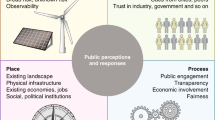Abstract
Current government information policies and market-based instruments aimed at influencing the energy choices of consumers often ignore the fact that consumer behaviour is not fully reducible to individuals making rational conscious decisions all the time. The decisions of consumers are largely configured by shared routines embedded in socio-technical systems. To achieve a transition towards a decarbonized and energy-efficient system, an approach that goes beyond individual consumer choice and puts shared routines and system change at its centre is needed. Here, adopting a transitions perspective, we argue that consumers should be reconceptualized as users who are important stakeholders in the innovation process shaping new routines and enacting system change. We review the role of users in shifts to new decarbonized and energy-efficient systems and provide a typology of user roles.
This is a preview of subscription content, access via your institution
Access options
Subscribe to this journal
Receive 12 digital issues and online access to articles
$119.00 per year
only $9.92 per issue
Buy this article
- Purchase on Springer Link
- Instant access to full article PDF
Prices may be subject to local taxes which are calculated during checkout

Similar content being viewed by others
References
Aebischer, B. & Hilty, L. M. in ICT In novations for Sustainability: Advances in Intelligent Systems and Computing Vol. 310 (eds Hilty, L. M. & Aebischer, B. ) 71–103 (Springer, 2014).
van Heddeghem, W. et al. Trends in worldwide ICT electricity consumption from 2007 to 2012. Comput. Commun. 50, 64–76 (2014).
Young, A. US new car sales set for a record year: demand is soaring for small SUVs like Ford's Escape, Nissan's Rogue. International Business Times (29 December 2016); http://go.nature.com/bE2LD5
Sorrell, S., Dimitriopolous, J. & Sommerville, M. Empirical estimates of direct rebound effects: a review. Energy Policy 37, 1356–1371 (2009).
Gillingham, K., Rapson, D. & Wagner, G. The rebound effect and energy efficiency policy. Rev. Environ. Eco. Policy 10, 68–88 (2016).
Energy Efficiency Market Report 2014 (OECD/IEA, 2014).
Energy Efficiency Policy and Measures (World Energy Council, accessed 4 April 2016); http://go.nature.com/hIXQXr
The European Environment: State and Outlook 2015 (European Environment Agency, 2015).
Smith, A., Voß, J.-P. & Grin, J. Innovation studies and sustainability transitions: The allure of the multi-level perspective and its challenges. Res. Policy 39, 435–448 (2010).
Geels, F. W. & Schot, J. in Transitions to Sustainable Development: New Directions in the Study of Long Term Transformative Change (eds Grin, J., Rotmans, J. & Schot, J. ) Part I, 11–101 (Routledge, 2010).
Markard, J., Raven, R. & Truffer, B. Sustainability transitions: An emerging field of research and its prospects. Res. Policy 41, 955–967 (2012).
Shove, E., Pantzar, M. & Watson, M. The Dynamics of Social Practice: Everyday Life and how it Changes (Sage, 2012).
Sorrell, S. Reducing energy demand: A review of issues, challenges and approaches. Renew. Sust. Energy Rev. 47, 74–82 (2015).
Seyfang, G. & Smith, A. Grassroots innovations for sustainable development: towards a new research and policy agenda. Environ. Polit. 16, 584–603 (2007).
Hoogma, R., Kemp, R., Schot, J. & Truffer, B. Experimenting for Sustainable Transport: The Approach of Strategic Niche Management (Spon Press, 2002).
Penna, C. C. R. & Geels, F. W. Climate change and the slow reorientation of the American car industry (1979–2012): an application and extension of the Dialectic Issue LifeCycle (DILC) model. Res. Policy 44, 1029–1048 (2015).
Smith, A. & Raven, R. What is protective space? Reconsidering niches in transitions to sustainability. Res. Policy 41, 1025–1036 (2012).
Kemp, R., Schot, J. & Hoogma, R. Regime shifts to sustainability through processes of niche formation: the approach of strategic niche management. Technol. Anal. Strateg. 10, 175–196 (1998).
Schot, J. & Geels, F. W. Strategic niche management and sustainable innovation journeys: theory, findings, research agenda, and policy. Technol. Anal. Strateg. 20, 537–554 (2008).
Raven, R. in Governing the Energy Transition. Reality, Illusion or Necessity? (eds Loorbach, D. & Verbong, G. ) Ch. 6, 125–151 (Routledge, 2012).
Heiskanen, E., Nissilä, H. & Lovio, R. Demonstration buildings as protected spaces for clean energy solutions – the case of solar building integration in Finland. J. Clean. Prod. 109, 347–356 (2015).
van Lente, H. Promising Technology (Enschede, 1993).
Borup, M., Brown, N., Konrad, K. & van Lente, H. The sociology of expectations in science and technology. Technol. Anal. Strateg. 18, 285–298 (2006).
Harborne, P., Hendry, C. & Brown, J. The development and diffusion of radical technological innovation: the role of bus demonstrations projects in commercializing fuel cell technology. Technol. Anal. Strateg. 19, 167–188 (2007).
Hegger, D. L. T., van Vliet, J. & van Vliet, B. J. M. Niche management and its contribution to regime change: the case of innovation in sanitation. Technol. Anal. Strateg. 19, 729–746 (2007).
Bos, B. & Grin, J. “Doing” reflexive modernisation in pig husbandry: the hard work of changing the course of a river. Sci. Technol. Hum. Val. 33, 480–507 (2008).
Geels, F. W. & Verhees, B. Cultural legitimacy and framing struggles in innovation journeys: a cultural- performative perspective and a case study of Dutch nuclear energy (1945–1986). Res. Policy 78, 910–930 (2011).
Lovins, A. B. Energy strategy: the road not taken? Foreign Aff. 55, 65–96 (1976).
Hekkert, M. P., Suurs, R. A. A., Negro, S. O., Kuhlmann, S. & Smits, R. E. H. M. Functions of innovation systems: a new approach for analysing technological change. Technol. Forecast. Soc. 74, 413–432 (2007).
Bergek, A., Jacobsson, S., Carlsson, B., Lindmark, S. & Rickne, A. Analyzing the functional dynamics of technological innovation systems: A scheme of analysis. Res. Policy 37, 407–429 (2008).
Jacobsson, S. & Lauber, V. The politics and policy of energy system transformation – explaining the German diffusion of renewable energy technology. Energy Policy 34, 256–276 (2006).
Seyfang, G. & Haxeltine, A. Growing grassroots innovations: exploring the role of community-based initiatives in sustainable energy transitions. Environ. Plann. C 30, 381–400 (2012).
Hargreaves, T., Hielscher, S., Seyfang, G. & Smith, A. Grassroots innovations in community energy: The role of intermediaries in niche development. Glob. Environ. Change 23, 868–880 (2013).
Ornetzeder, M. & Rohracher, H. Of solar collectors, wind power, and car sharing: comparing and understanding successful cases of grassroots innovations. Glob. Environ. Change 23, 856–867 (2013).
Ornetzeder, M. & Rohracher, H. User-led innovations and participation processes: lessons from sustainable energy technologies. Energy Policy 34, 138–150 (2006).
Windturbines in Denmark (Danish Energy Agency, 2009).
Jorgensen, U. & Karnøe, P. in Managing Technology in Society: The Approach of Constructive Technology Assessment (eds Rip, A., Misa, T. J. & Schot, J. ) 57–82 (Pinter, 1995).
Truffer, B. User-led innovation processes: the development of professional car sharing by environmentally concerned citizens. Innovation 16, 139–154 (2003).
Mobility Cooperative; http://go.nature.com/VjFTuj
Rip, A. & Kemp, R. in Human Choice and Climate Change Vol. 2. (eds Rayner, S. & Malone, E. L. ) Ch. 6, 327–399 (Battelle Press, 1998).
van Lente, H., Hekkert, M., Smits, R. & van Waveren, B. Roles of systemic intermediaries in transition processes. Int. J. Innov. Manage. 7, 247–279 (2003).
Stewart, J. & Hyysalo, S. Intermediaries, users and social learning in technological innovation. Int. J. Innov. Manage. 12, 295–325 (2008).
Argyris, C. & Schön, D. A. Organizational Learning: A Theory of Action Perspective (Addison-Wesley, 1978).
Sabatier, P. A. Knowledge, policy-oriented learning, and policy change: an advocacy coalition framework. Sci. Commun. 8, 649–692 (1987).
Rosenberg, N. Inside the Black Box: Technology and Economics (Cambridge Univ. Press, 1982).
Lundvall, B.-Å . in Technical Change and Economic Theory (eds Dosi, G., Freeman, C., Nelson, R., Silverberg, G. & Soete, L. ) Ch. 17, 349–369 (Pinter, 1988).
Fleck, J. Innofusion or Diffusation? The Nature of Technological Development in Robotics PICT Working Paper No. 4 (Univ. Edinburgh, 1988).
Silverstone, R. & Hirsch, E. (eds) Consuming Technologies: Media and Information in Domestic Spaces (Routledge, 1992).
Oudshoorn, N. & Pinch, T. J. How Users Matter: The Co-Construction of Users and Technology (MIT Press, 2003).
Cowan, R. S. in The Social Construction of Technological Systems (eds Bijker, W. E., Hughes, T. P. & Pinch, T. J. ) 261–280 (MIT Press, 1987).
Nye, D. E. Electrifying America: Social Meanings of a New Technology, 1880–1940 (MIT Press, 1990).
Bruhèze, A. A. de la & Oldenziel, R. (eds) Manufacturing Technology, Manufacturing Consumers (Aksant, 2009).
Oldenziel, R. & Hård, M. Consumers, Tinkerers, Rebels: The People Who Shaped Europe (Palgrave Macmillan, 2013).
von Hippel, E. Lead users: a source of novel product concepts. Manag. Sci. 32 791–805 (1986).
Von Hippel, E. A. & Tyre, M. J. How learning by doing is done: problem identification in novel process equipment. Res. Policy 24, 1–12 (1995).
Jervan, H., Onsager, K. & Aasen, B. The Role of Public Sector Users in the Development of Environmental Technology (Gruppen for Ressursstudier, 1989).
Hoogma, R. & Schot, J. in Technology and the Market: Demand, Users and Innovation (eds Coombs, R., Green, K., Richards, A. & Walsh, V. ) Ch. 11, 216–233 (Edward Elgar, 2001).
Smith, A., Hargreaves, T., Hielscher, S., Martiskainen, M. & Seyfang, G. Making the most of community energies: Three perspectives on grassroots innovation. Environ. Plann. A 48, 407–432 (2016).
Berker, T., Hartmann, M., Punie, Y. & Ward, K. J. Domestication of Media and Technology (Open Univ. Press, 2005).
Hargreaves, T., Nye, M. & Burgess, J. Making energy visible: A qualitative field study of how householders interact with feedback from smart energy monitors. Energy Policy 38, 6111–6119 (2010).
Wrapson, W. & Devine-Wright, P. ‘Domesticating’ low carbon thermal technologies: diversity, multiplicity and variability in older person, off grid households. Energy Policy 67, 807–817 (2014).
Hyysalo, S., Juntunen, J. K. & Freeman, S. User innovation in sustainable home energy technologies. Energy Policy 55, 490–500 (2013).
Unruh, G. C. Understanding carbon lock-in. Energy Policy 28, 817–830 (2000).
Jolly, S. & Raven, R. P. J. M. Collective institutional entrepreneurship and contestations in wind energy in India. Renew. Sust. Energy Rev. 42, 999–1011 (2015).
Turnheim, B. & Geels, F. W. The destabilisation of existing regimes: Confronting a multi-dimensional framework with a case study of the British coal industry (1913–1967). Res. Policy 42, 1749–1767 (2013).
Meadows, D. H., Meadows, D. L., Randers, J. & Behrens, W. W. The Limits to Growth: A Report for Club of Rome's Project on the Predicament of Mankind (Universe Books, 1972).
Stern, P. C. Toward a coherent theory of environmentally significant behavior. J. Soc. Issues 56, 407–424 (2000).
Anable, J., Lane, B. & Kelay, T. An Evidence Based Review of Public Attitudes to Climate Change and Transport Behaviour (UK Department for Transport, 2006); http://www.china-up.com:8080/international/case/case/1457.pdf
Sovacool, B. K. & Brown, M. A. Deconstructing facts and frames in energy research. Maxims for evaluating contentious problems. Energy Policy 86, 36–42 (2015).
Sovacool, B. K. & Blyth, P. L. Energy and environmental attitudes in the green state of Denmark: implications for energy democracy, low carbon transitions, and energy literacy. Environ. Sci. Policy 54, 304–315 (2015).
Norton, P. D. Fighting Traffic: The Dawn of the Motor Age in the American City (MIT Press, 2008).
Acknowledgements
This project has received funding from the European Union's Seventh Framework Programme for research, technological development and demonstration under grant agreement no. 613194. We would also like to thank our many colleagues in the transition and innovation communities, the EU-Innovate EU project (http://www.euinnovate.com/en), the Science Policy Research Unit of the University of Sussex and the Department of Innovation Sciences of the Eindhoven University of Technology, who have commented on earlier versions and contributed to our thinking.
Author information
Authors and Affiliations
Corresponding author
Ethics declarations
Competing interests
The authors declare no competing financial interests.
Rights and permissions
About this article
Cite this article
Schot, J., Kanger, L. & Verbong, G. The roles of users in shaping transitions to new energy systems. Nat Energy 1, 16054 (2016). https://doi.org/10.1038/nenergy.2016.54
Received:
Accepted:
Published:
DOI: https://doi.org/10.1038/nenergy.2016.54
This article is cited by
-
Social–financial approach for analyzing financial transitions
Financial Innovation (2023)
-
Agents of change or victims of transition? Media framings on household roles during the energy crisis
Sustainability Science (2023)
-
Optimal control of output power of micro-inverter based on circuit design
International Journal of System Assurance Engineering and Management (2023)
-
Matching consumer segments to innovative utility business models
Nature Energy (2021)



